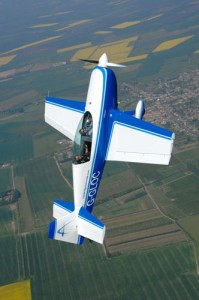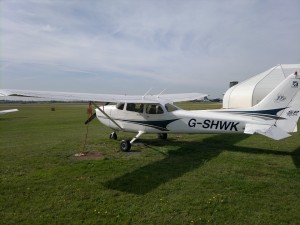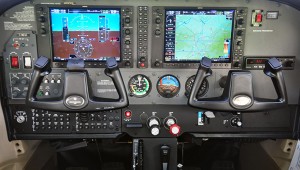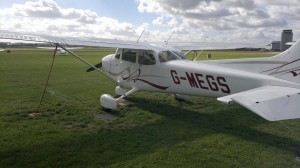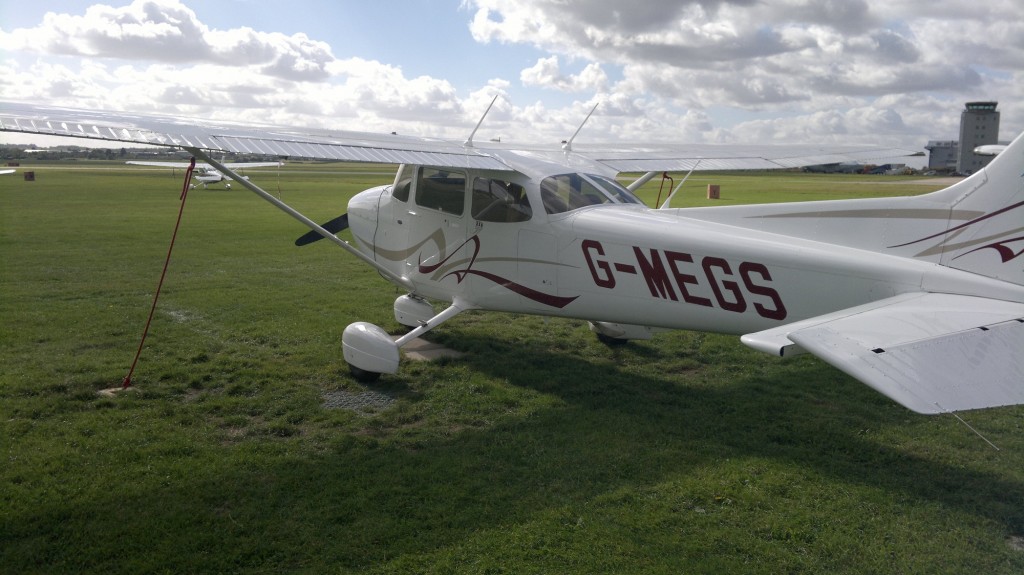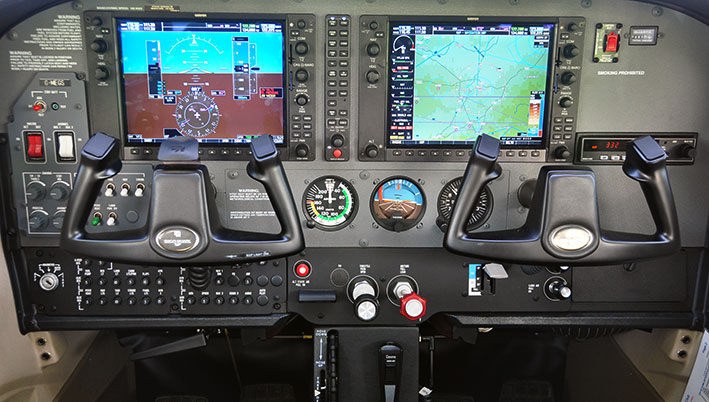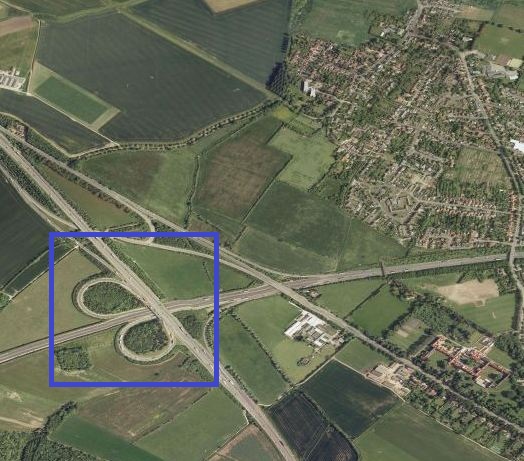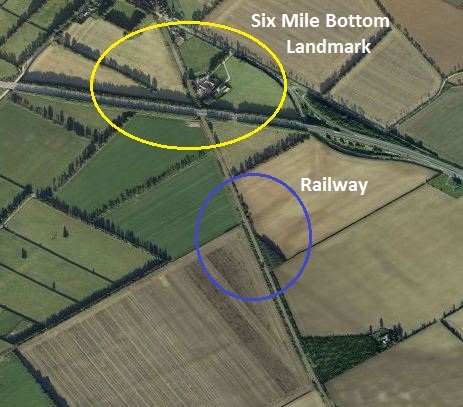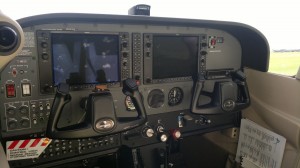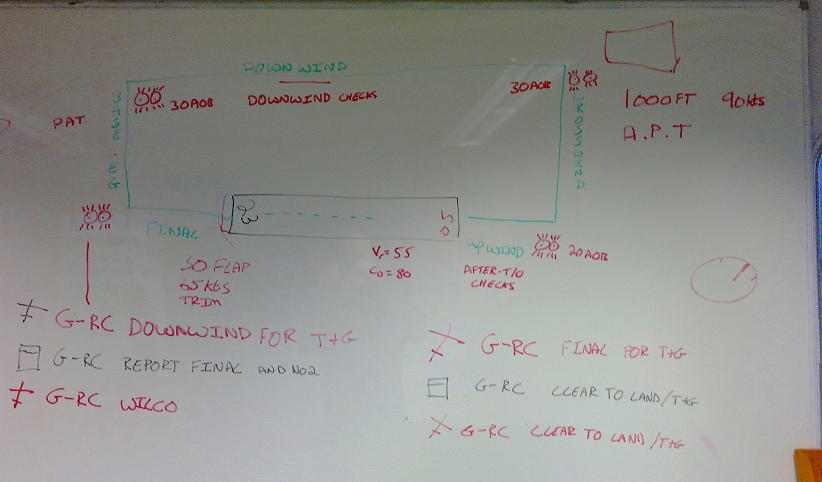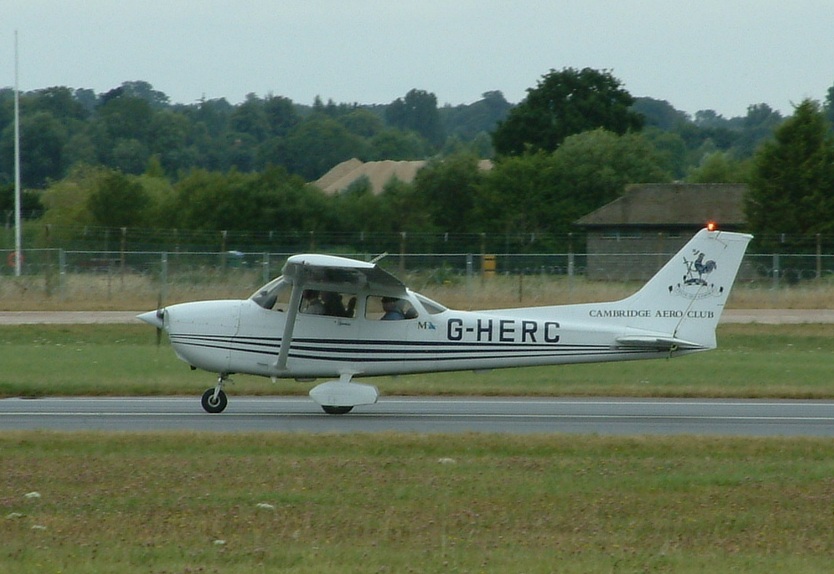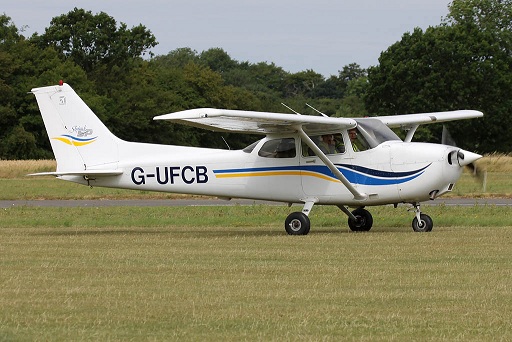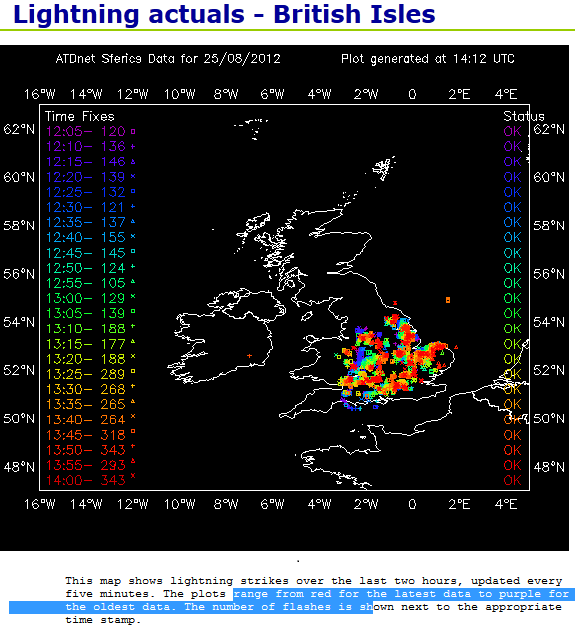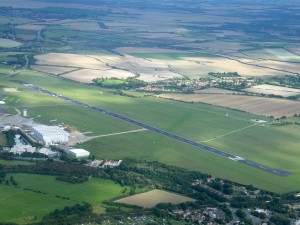After the mess the day before, I was hoping for better things the following morning. The weather looked like it was going to do its bit at least.
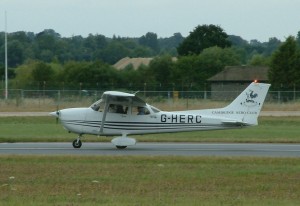
G-HERC (Golf Hotel Echo Romeo Charlie)
Upon arrival I discovered the new instructor who’d had to put up with my efforts to land yesterday, was once again signed up to another session. I was sort of hopeful that wouldn’t have been the case, but only on subconscious effects on my flying.
Multiple signatures later to declare I’d read everything, had appropriate pieces of paper with me and giving provision for, if all went well, the instructor to hop out at any time (well almost any time).
Just to be different we took Romeo Charlie today (G-HERC), funny really I fly this plane rarely but the major moments always appear to happen in it: My first ever flight in a C172, my first Solo etc. all in Romeo Charlie.
There was some debate in the club as to whether runway 23 or 05 should be used, the computer said 23 was the active runway, but the wind said 05 should be. The Deputy Chief Flying Instructor said he’d give the tower a call and suggest 05, I didn’t mind too much which way round I flew, though a bit conscious that it’s pretty rare to fly 05.
Checkout & Taxi
A broken taxi light, but other than that a plane full of fuel and looking good.
No mass checklist item misses today, just turned the landing light on and forgetting the strobes (arrgh).
Sure enough the runway direction had changed and we now had the long old task of taxing down to Delta (Google tells me it’s a 820m trek!).
Circuit #1 – Tiger Moth in the Circuit!
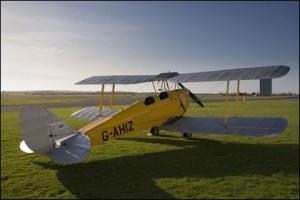 The take off was going really quite well, a bit of divergence from the straight line of the runway (after take off), but generally not a bad climb out.
The take off was going really quite well, a bit of divergence from the straight line of the runway (after take off), but generally not a bad climb out.
As I began the turn onto the crosswind leg, it became very apparent that we had a Tiger Moth (G-AHIZ) in front of us (also doing circuits), ATC confirmed this with an advisory call.
My problem now was that while I was just about to throttle back and settle into a 90kt circuit, he must have been doing no more than 80kts – a bit of obvious math suggested we were going to catch him, and catch him quite soon.
It was helpful that the tiger moth was flying a slightly wider circuit then me and helped much more when my instructor radioed Air Traffic Control and requested a reposition, to put us in front of the tiger moth for the approach. Not much sooner was this granted, then we were passing him a few hundred meters on our left. I can imagine it was a lot of fun being in that other plane, I must look into having a go one day.
Now I just had to try and not embarrass myself on the approach & landing, checks and radio calls done just a matter of getting a good landing.
It could have been a touch better: I needed to add a touch of power just before we crossed the threshold, a bit more of a bump then I’d like, but it flew down to the runway nice and nothing harder then I’ve had from most instructors so I came away from it pretty happy.
Flaps up, power on, we were off again…….no time to wait, there was a tiger moth coming in on 05 grass (now to our right), so we had to get airborne and get past the crosswind leg before he was into a climb.
Circuit #2
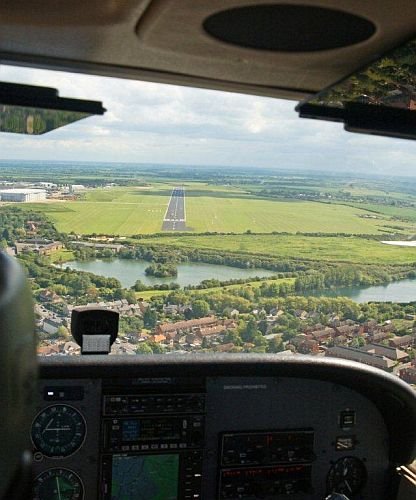
Runway 05 - Water then a Mile of runway
The climb out could still have been straighter, but another nice circuit, good speeds, no headaches from the plane and give or take 20ft, 1000ft constant. All the problems of the day before had vanished.
Pre-landing checks done and radio calls all sorted, all that remained was a good approach.
Easier said then done, because of the sinking affect you get from flying over water, I tend to fly in with a bit more power on to compensate as the plane goes over the water.
Might have overdone it a bit, came in over the water on the high side, really quite high. My instructor just remarked “It’s a big runway….”
Sure enough, it might not have touched down ‘on the numbers’, but maybe 100ft later we were down and it was a fairly nice landing, perhaps I could have got the nose a bit higher, but it wasn’t flat and it didn’t bounce or skid, so you can’t ask for much more 🙂
Circuit #3 – Flapless
Flying it in with flaps was going well, now to try one flapless.
Finally got the climb out to be absolutely on the money and another good circuit, things were looking up for maybe going solo today.
Without flaps it’s harder to lose the height, so I radioed air traffic to inform them we’d be doing a flapless approach and then extended downwind so we’d have a good long stretch of final.
Another nice touch down in the bag.
Circuit #4
This is normally the deciding moment, four good circuits and the instructor will get out to ensure there’s enough remaining time to do a bit solo.
On the downwind leg, air traffic asked if we could accept an 05 Grass landing. I’ve landed on the grass before, but never on 05, so my instructor declined the request and proposed we orbit instead if they needed time. Air traffic decided against that plan and just told us to continue.
A bit of a bump on the landing, I’d had better, but it was good enough. Time to taxi to the tower and let the instructor get out – then we’d see if I could do some on my own (not that he’d touched the controls all flight anyway).
Solo Flight Number #4
With a few passing reminders and instruction to go and try maybe 2 normal and 2 flapless landings, the most continuous number of circuits I’d have ever done on my own. The instructor got out and I was on my own in the plane.
I’d decided I was going to do the first two normal, then the second two I’d do flapless and keep what I was doing on each circuit fairly straight forward to remember.
Solo Circuit #1
I made sure the transponder and everything else was set before declaring ready for departure, there was a plane in the circuit so I was expecting the call back to be to “Hold”, but not today, I was given clearance to take-off…….so unexpected was this, that as I began to taxi on to the runway I was double & triple checking the approach, just in case. Then just before turning on to the runway I spotted the other plane was still on the downwind leg, I’d be well clear before he was anywhere near final approach.
Throttle fully open and we were off.
It doesn’t get better than this, charging down a one mile runway solo and about to take off.
The climb out wasn’t as straight as I was hoping to demonstrate, but it wasn’t too bad, followed by a pretty good circuit. Actively thinking all the way round, remembering radio calls and checks, the altitudes and speeds today were all about as good as they’re ever going to get.
Found myself coming in a bit high on final, but with full flaps extended and the usual sink of crossing the water it would come right. 80ft, 50ft, 20ft, raise the nose a little more…..and we were down.
There’s a handful of moments to enjoy it, before you need to be back thinking “Raise the flaps”, “Power On…..” and you’re pretty soon back in the air.
Solo Circuit #2 : The Tiger Moth returns….
As I was on the climb out, the tiger moth was back just turning on to down wind. All I could now think about was “give him space……we don’t want to catch that.”
I knew I was going to be going faster so I tried to slow the rate of climb a little, but there’s only so far out you can go. Turning on to crosswind, I again tried to slow it all down, climb slower and let him get as far away as possible.
Downwind I lost visual with the tiger moth, Air Traffic Control told me I was number 2 in the circuit and then I suffered a visual illusion that has been known to catch pilots out in the past. In the distance of the downwind leg something was reflecting, I figured “Ok, that’s the tiger moth.” For maybe 20 seconds I kept looking back at this point while continuing a good lookout for anything else (you get a ton of traffic at Cambridge). Then, just as I was starting to conclude this scenario was impossible, I should be catching the moth in front of me, I glanced towards the final approach leg……and spotted the real tiger moth!
It was a slight sense of relief, he was well clear of me and I could now crack on with getting ready for base and final with confidence that there should be no issues with separation or clearances to land.
Considering this was with flaps, it was another nice landing. I’m getting to quite like flying Runway 05, for the few times I’ve done it, it always seems to go well.
Solo Circuit #3 : Flapless
Time to switch on to doing a couple of flapless landings.
All my efforts to slow it all down and buy some separation had worked, there was no need to be concerned with the tiger moth.
This circuit could just be enjoyed and I was properly enjoying myself, still actively thinking lots about everything, but having moments of “My god this is good….”
Just under a year since I had my first trial flight in this very plane, I was now flying it solo.
Having informed Air Traffic I was going to do this approach flapless, I extended the downwind a little to give myself plenty of final approach to get height and speeds sorted out.
Bit more of a bump on touch down then my normal flapless landings, but nothing I’d be ashamed of, plenty good enough. One more and we’d call it a day, I’d been flying for well over an hour now.
Solo Circuit #4 : No Clearance to Land! (Oooopps!)
Finishing the climb up and turning on to crosswind, there was the Tiger Moth, again! Closer than ever, oh we were going to catch it this time…..
At first I thought I might be able to build some distance by slowing it down, extending the crosswind a little and all those sort of tricks, but as I got onto the downwind, forget it. I was getting ever closer to him. He radioed downwind, a few seconds later I radioed downwind…..to land.
My air-to-air estimates of distance aren’t probably the best, but I’d guestimate we had about 600-800m of separation. This was all getting to close for comfort, I love vintage planes and I really didn’t want to be the cause for there being one less in the world (nor did I want the headlines “Student Pilot wipes out Tiger Moth….”).
Time to do something…….with a click of the Push To Talk radio button, I requested permission from air traffic control to do an orbit (a big 360 degree circle, flown at a constant 30 degrees of bank). Probably fully aware I was getting pretty close to the Moth, ATC authorised the orbit.
My latest instructor has never seen me orbit, but he was about to watch one from the ground, if I do one thing half well, it’s circles at 1000ft 🙂
By the time I was finished the Tiger Moth was well on its way on final approach, a quick radio call from me to tell ATC the orbit was complete (more to check if I could continue or needed to do something else) it was back to the job of aiming to land.
There was a key radio call at this point:
“……report final.”
“Number 2, Wilco, Golf Romeo Charlie.”
I’d agreed, as is normal, to tell air traffic once I was on final approach. Nothing new, this back-and-forth happens most circuits (except for the number 2 part, but I was following the Moth).
No problems, except for the fact I was clearly enjoying myself so much, that 200ft off the floor it suddenly dawned on me:
“Arrrrgh, I haven’t called final…….”
Right at that moment, some other plane made a radio call (damn it!). Now what the hell do you do? I was below decision height, I wasn’t technically cleared to land, ATC knew I was in the circuit, they knew I was a student so hopefully they were being vigilant for me. No worries, a quick call and we might fix this……
“………Say again………”
Ohhh for god sake, of all the times to not hear the radio, now ATC had to repeat themselves and the other guy would have to read back the call. Out of time. Less than 100ft off the deck, time to make a decision and my 10 millisecond decision process went like this:
- Aviate
- Navigate
- Communicate
At this altitude, with a handful of seconds to decide what to do next, I decided the safest thing I could do was land it. Hindsight is 20:20, but that was the decision I made in the moment. Going around presented its own risks, the longer you’re in the air, the greater your probability of failure. Excuses and explanations out of the way though, in hindsight the correct thing to do was probably a go around. I’m going to play the “You learn from your failures” and “this is what being a student is all about” card…..
Debriefing
Not surprisingly a debriefing that consisted of “any problems? No, good…..looked fine from the tower.” Stopped with a moment of:
Were you cleared to land on that final one?
What can you do…..I just had to smile and say “Maybe not……I realised, then I couldn’t get on the radio.” A reminder that in this case I should have gone around. Like I said, you will make these sort of errors along the way, it’s part of the learning experience and this one I just have to chalk up and not repeat.
Other than that last moment though, by a country mile, a fantastic lesson. Totally contrasting the day before.
The Circuit Milestone is within reach.
Just as I was paying up, my ‘regular’ (or at least the most featured name in my log book) instructor did the math on how much more circuit time I had to complete: 40 Minutes that’s just 4 solo circuits, then we’re done with the campaign of flying in circles. If the weather holds and I don’t botch the lesson, we could have this ticked off by the next lesson!
Very excited…….better get a few exams done. Next up, Human Factors.
